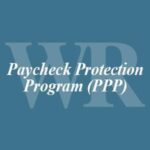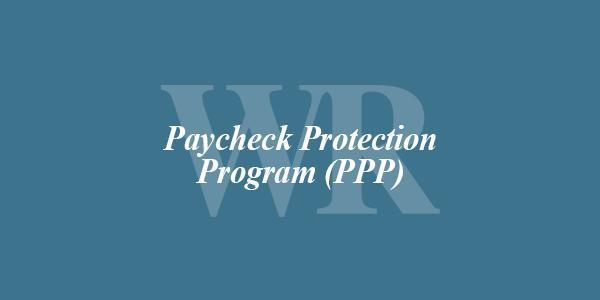
Paycheck Protection Program Update
April 7, 2020
Paycheck Protection Program Update
April 9, 2020Paycheck Protection Program Update

Last night the SBA and US Treasury put out additional Q&A’s regarding the PPP that clarifies some of our thinking and, thankfully, our interpretations and positions to this point have been correct. Below are several of the questions that are apply to many of our clients’ situations. The full document can be found here: https://home.treasury.gov/system/files/136/Paycheck-Protection-Program-Frequenty-Asked-Questions.pdf
Question: The CARES Act excludes from the definition of payroll costs any employee compensation in excess of an annual salary of $100,000. Does that exclusion apply to all employee benefits of monetary value?
Answer: No. The exclusion of compensation in excess of $100,000 annually applies only to cash compensation, not to non-cash benefits, including:
- employer contributions to defined-benefit or defined-contribution retirement plans;
- payment for the provision of employee benefits consisting of group health care coverage, including insurance premiums; and
- payment of state and local taxes assessed on compensation of employees.
Question: Do PPP loans cover paid sick leave?
Answer: Yes. PPP loans covers payroll costs, including costs for employee vacation, parental, family, medical, and sick leave. However, the CARES Act excludes qualified sick and family leave wages for which a credit is allowed under sections 7001 and 7003 of the Families First Coronavirus Response Act (Public Law 116–127). Learn more about the Paid Sick Leave Refundable Credit here.
Question: My small business is a seasonal business whose activity increases from April to June. Considering activity from that period would be a more accurate reflection of my business’s operations. However, my small business was not fully ramped up on February 15, 2020. Am I still eligible?
Answer: In evaluating a borrower’s eligibility, a lender may consider whether a seasonal borrower was in operation on February 15, 2020 or for an 8-week period between February 15, 2019 and June 30, 2019.
Question: What if an eligible borrower contracts with a third-party payer such as a payroll provider or a Professional Employer Organization (PEO) to process payroll and report payroll taxes?
Answer: SBA recognizes that eligible borrowers that use PEOs or similar payroll providers are required under some state registration laws to report wage and other data on As of April 6, 2020 the Employer Identification Number (EIN) of the PEO or other payroll provider. In these cases, payroll documentation provided by the payroll provider that indicates the amount of wages and payroll taxes reported to the IRS by the payroll provider for the borrower’s employees will be considered acceptable PPP loan payroll documentation. Relevant information from a Schedule R (Form 941), Allocation Schedule for Aggregate Form 941 Filers, attached to the PEO’s or other payroll provider’s Form 941, Employer’s Quarterly Federal Tax Return, should be used if it is available; otherwise, the eligible borrower should obtain a statement from the payroll provider documenting the amount of wages and payroll taxes. In addition, employees of the eligible borrower will not be considered employees of the eligible borrower’s payroll provider or PEO.
Question: May lenders accept signatures from a single individual who is authorized to sign on behalf of the borrower?
Answer: Yes. However, the borrower should bear in mind that, as the Borrower Application Form indicates, only an authorized representative of the business seeking a loan may sign on behalf of the business. An individual’s signature as an “Authorized Representative of Applicant” is a representation to the lender and to the U.S. government that the signer is authorized to make the certifications, including with respect to the applicant and each owner of 20% or more of the applicant’s equity, contained in the Borrower Application Form. Lenders may rely on that representation and accept a single individual’s signature on that basis.
Question: What time period should borrowers use to determine their number of employees and payroll costs to calculate their maximum loan amounts?
Answer: In general, borrowers can calculate their aggregate payroll costs using data either from the previous 12 months or from calendar year 2019. For seasonal businesses, the applicant may use average monthly payroll for the period between February 15, 2019, or March 1, 2019, and June 30, 2019. An applicant that was not in business from February 15, 2019 to June 30, 2019 may use the average monthly payroll costs for the period January 1, 2020 through February 29, 2020. Borrowers may use their average employment over the same time periods to determine their number of employees, for the purposes of applying an employee-based size standard. Alternatively, borrowers may elect to use SBA’s usual calculation: the average number of employees per pay period in the 12 completed calendar months prior to the date of the loan application (or the average number of employees for each of the pay periods that the business has been operational, if it has not been operational for 12 months).
Question: Should payments that an eligible borrower made to an independent contractor or sole proprietor be included in calculations of the eligible borrower’s payroll costs?
Answer: No. Any amounts that an eligible borrower has paid to an independent contractor or sole proprietor should be excluded from the eligible business’s payroll costs. However, an independent contractor or sole proprietor will itself be eligible for a loan under the PPP, if it satisfies the applicable requirements.
Question: How should a borrower account for federal taxes when determining its payroll costs for purposes of the maximum loan amount, allowable uses of a PPP loan, and the amount of a loan that may be forgiven?
Answer: Under the Act, payroll costs are calculated on a gross basis without regard to (i.e., not including subtractions or additions based on) federal taxes imposed or withheld, such as the employee’s and employer’s share of Federal Insurance Contributions Act (FICA) and income taxes required to be withheld from employees. As a result, payroll costs are not reduced by taxes imposed on an employee and required to be withheld by the employer, but payroll costs do not include the employer’s share of payroll tax. For example, an employee who earned $4,000 per month in gross wages, from which $500 in federal taxes was withheld, would count as $4,000 in payroll costs. The employee would receive $3,500, and $500 would be paid to the federal government. However, the employer-side federal payroll taxes imposed on the $4,000 in wages are excluded from payroll costs under the statute.
As you begin collecting payroll information and working on your loan application, let us know if you need assistance. We are here to help. Reach out to your WR Partner or you relationship manager. You can also email our COVID-19 task force for assistance: COVID19TASKFORCE@websterrogers.com.
Sincerely,
WR COVID-19 Task Force


